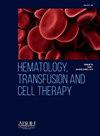THE ROLE OF PSMA PET/CT IN THE CHARACTERIZATION OF HEAD AND NECK SQUAMOUS CELL CARCINOMA
IF 1.8
Q3 HEMATOLOGY
引用次数: 0
Abstract
Introduction/Justification
Head and neck squamous cell carcinoma (HNSCC) is an aggressive malignancy, often diagnosed at advanced stages. The 18-fluorodeoxyglucose positron emission tomography/computed tomography (18F-FDG PET/CT) reflects glycolytic activity in tissues and has been widely used for staging and monitoring HNSCC. However, its specificity is limited by false positives in inflammatory processes. PET/CT with prostate-specific membrane antigen (PSMA) has been investigated as an alternative to 18F-FDG due to its expression in tumor neovasculature, but its role in HNSCC remains unclear.
Objectives
To evaluate the uptake patterns of 18F-PSMA-1007 PET/CT in HNSCC, in comparison with 18F-FDG PET/CT, aiming to explore its potential in tumor characterization, staging, and monitoring.
Materials and Methods
Patients with advanced locoregional HNSCC, either at initial diagnosis or with tumor relapses, were enrolled in the study. Individuals who had undergone surgical tumor resection or received chemotherapy and/or radiotherapy within the last six months were excluded. All enrolled patients underwent 18F-FDG PET/CT and 18F-PSMA-1007 PET/CT imaging, with a 24-hour interval between the exams. The images were analyzed independently by two nuclear medicine physicians and one radiologist. Statistical comparisons between groups were performed using the t-test, with significance set at P < 0.05.
Results
Fourteen patients (nine at initial diagnosis, five with recurrent disease) were analyzed using both PET/CT imaging modalities. The median age was 61 years (range: 49-81), with eleven males and three females. Most patients were current or former smokers and alcohol consumers, had good performance status (ECOG 0), and presented with stage IV tumors. The primary tumors were located in the oropharynx, larynx, and oral cavity, with one sinonasal tumor. Recurrences, were observed in locoregional lymph nodes, lungs, and bones. HNSCC lesions were typically characterized by FDG uptake, although most lesions also exhibited varying degrees of PSMA uptake. In primary tumors and nodal disease, the mean ± SD and median (range) SUV values obtained with FDG PET/CT at 1 hour were 25.6 ± 16.4 and 21.0 (10.7–59.8), and 11.7 ± 7.7 and 8.6 (2.7-26.4), respectively. For PSMA PET/CT, the mean ± SD and median (range) SUV values at 1 hour in primary tumors and nodal disease were 4.5 ± 1.3 and 4.3 (2.9-6.3), and 4.9 ± 2.6 and 3.9 (2.8-10.2), respectively. FDG uptake values were higher than PSMA uptake values in primary tumors (P < 0.001) and lymph nodes (P = 0.01).
Conclusion
HNSCC lesions were more effectively detected by FDG PET/CT, highlighting its superior sensitivity for assessing tumor activity. However, PSMA uptake in most tumors suggests the coexistence of glycolytic activity and neoangiogenesis, reinforcing the value of integrating FDG and PSMA PET for tumor characterization, staging, and monitoring. The pronounced PSMA expression in certain cases supports the feasibility of theranostic PSMA-targeted therapies or anti-angiogenic treatments. Further research is needed to elucidate the relationship between PSMA expression, tumor angiogenesis, and HNSCC biology. Acknowledgements: The study was supported by Coordenação de Aperfeiçoamento de Pessoal de Nível Superior(CAPES) and Fundação de Apoio ao Ensino e à Pesquisa do Estado de São Paulo (Cancer Theranostics Innovation Center, CancerThera, FAPESP #2021/10265-8).
求助全文
约1分钟内获得全文
求助全文
来源期刊

Hematology, Transfusion and Cell Therapy
Multiple-
CiteScore
2.40
自引率
4.80%
发文量
1419
审稿时长
30 weeks
 求助内容:
求助内容: 应助结果提醒方式:
应助结果提醒方式:


